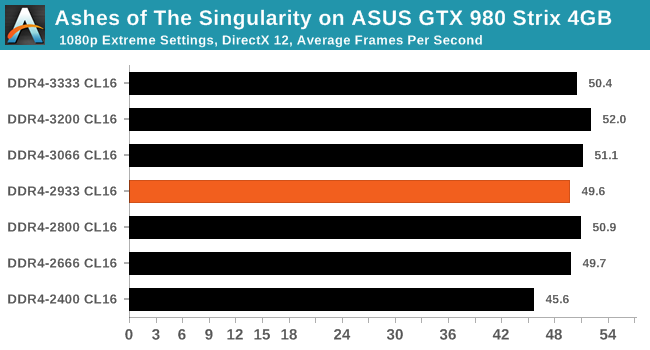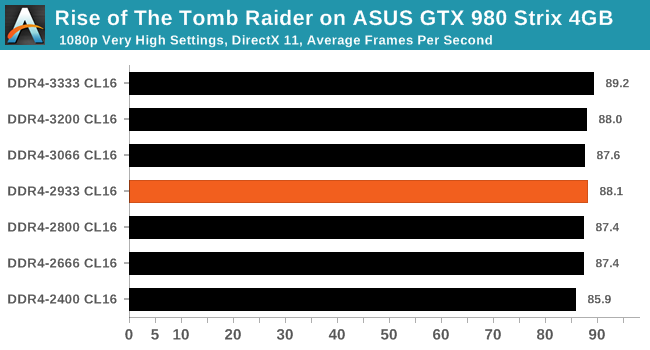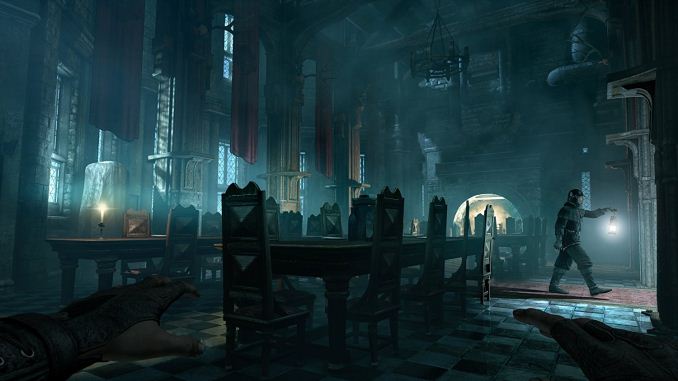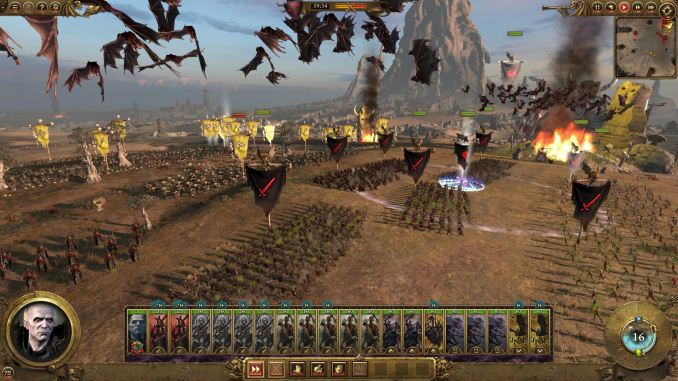Memory Scaling on Ryzen 7 with Team Group's Night Hawk RGB
by Ian Cutress & Gavin Bonshor on September 27, 2017 11:05 AM ESTGaming Performance
Ashes of the Singularity (DX12)
Seen as the holy child of DX12, Ashes of the Singularity (AoTS, or just Ashes) has been the first title to actively go and explore as many of the DX12 features as it possibly can. Stardock, the developer behind the Nitrous engine which powers the game, has ensured that the real-time strategy title takes advantage of multiple cores and multiple graphics cards, in as many configurations as possible.

Performance with Ashes over our different memory settings was varied at best. The DDR4-2400 value can certainly be characterized as the lowest number near to ~45-46 FPS, while everything else is rounded to 50 FPS or above. Depending on the configuration, this could be an 8-10% difference in frame rates by not selecting the worst memory.
Rise Of The Tomb Raider (DX12)
One of the newest games in the gaming benchmark suite is Rise of the Tomb Raider (RoTR), developed by Crystal Dynamics, and the sequel to the popular Tomb Raider which was loved for its automated benchmark mode. But don’t let that fool you: the benchmark mode in RoTR is very much different this time around.
Visually, the previous Tomb Raider pushed realism to the limits with features such as TressFX, and the new RoTR goes one stage further when it comes to graphics fidelity. This leads to an interesting set of requirements in hardware: some sections of the game are typically GPU limited, whereas others with a lot of long-range physics can be CPU limited, depending on how the driver can translate the DirectX 12 workload.

We encountered insignificant performance differences in RoTR on the GTX 980. The 3.3 FPS increase at average framerates from top to bottom does not exactly justify the price cost between DDR4-2400 and DDR4-3333 when using a GTX 980 - not in this particular game at least.
Thief
Thief has been a long-standing title in the hearts of PC gamers since the introduction of the very first iteration back in 1998 (Thief: The Dark Project). Thief is the latest reboot in the long-standing series and renowned publisher Square Enix took over the task from where Eidos Interactive left off back in 2004. The game itself uses the UE3 engine and is known for optimised and improved destructible environments, large crowd simulation and soft body dynamics.

For Thief, there are some small gains to be had from moving through from DDR4-2400 to DDR4-2933, around 5% or so, however after this the performance levels out.
Total War: WARHAMMER
Not only is the Total War franchise one of the most popular real time tactical strategy titles of all time, but Sega has delved into multiple worlds such as the Roman Empire, the Napoleonic era, and even Attila the Hun. More recently the franchise has tackeld the popular WARHAMMER series. The developers Creative Assembly have integrated DX12 into their latest RTS battle title, it aims to take benefits that DX12 can provide. The game itself can come across as very CPU intensive, and is capable of pushing any top end system to their limits.

Even though Total War: WARHAMMER is very CPU performance focused benchmark, memory had barely any effect on the results.














65 Comments
View All Comments
HStewart - Wednesday, September 27, 2017 - link
I think of this way, AMD was desperate to get back into business of CPU's, but financially they had some issues to really think it though. So they created an 8 Core Zen and then clunk them together so that they claim higher core count. This designed is likely primary why it does not scaled.But they did something that they probably didn't want to here - they ignored that Intel has been making higher core CPU's in the Xeon and that it quite simple for them to place them in gaming machines. This has a good side effect for Intel owners, because it means it keeps Intel on its toes - but the bad news I am afraid is that AMD will not be financially able to keep up with core wars and eventually have to drop - also purchasing ATI has alienated potential buyers - who in right mind would purchase an AMD GPU on Intel CPU.
One thing that is interesting, is that Intel and the industry is moving in a different direction. Mobile is where the industry is going not huge fat desktops. This is a place where AMD is missing the mark and could possible complete loose it enter company open and solely based there efforts on the desktop industry.
duploxxx - Thursday, September 28, 2017 - link
lol dude what have you been smoking?A) its intel that responded on AMD core count
B) Zen 8 core multi die was in the design from the start to keep cost low
C) Xeon v2 and v3 both had issues with scale out on core hence the reason for the new grid which is sub optimal on caching.
D) Intel has a way more expensive die, you forget that they ask 2500+ euro upto 14000 euro for there 16+ cores? while AMD charges 4000 euro for 32 cores. The gold series dont even come close to AMD offerings in cores.
E) Intel is not moving at all, they own the biggest part of the industry on x86 and that is what they try to keep. THey lost the low power war vs ARM and they sure try to get into IOT with lots of money but it aint that easy.
F)AMD has low budget so they infiltrate markets where they believe they can gain.
cap87 - Friday, September 29, 2017 - link
Intel didn’t respond to AMD with higher core counts, processors are designed years in advance, suggesting otherwise is just plain ignorance. What they did do was push forward the release date of Coffee Lake thanks to AMD’s pressure.jospoortvliet - Saturday, September 30, 2017 - link
Their design was meant for servers. Bringing the 18 cores suddenly to the high end desktop was most certain my something they kept as an ace option but it wasn't their original plan and that is obvious from the way it was rushed to market, being months later than the 10 core model and many of the earlier motherboards barely or simply not able to handle the load. They are also obviously clocked very high with barely room for overclock and breaking their tdp, throttling under heavy use on many boards even without oc.Hixbot - Monday, October 9, 2017 - link
I'm tired of hearing this. what you are suggesting is ignorance.Intel had loads of time to R&D, yes designs take years, but they've had those years to design coffe lake with 4 cores, with 8 cores. They design and design, they could have designed a sandy bridge as 8 core and not released it. You think they need to take years to respond to a competitive push. Let me tell you, they can design all sorts of options "years in advance" and only bring to market what they choose. So if it weren't for Zen, we might be staring at a 4 core (max) coffee lake. OMG it's hilarious to see this "design takes years" argument. They can and do take years to design all sorts of potential processors, they can then choose what to bring to market in a much shorter time.
Arbie - Wednesday, September 27, 2017 - link
For what? Some small and very expensive ST performance increase? Consider what AMD has done for us in reigniting competition and moving the tech envelope forward. Think what that took, and whether they could possibly do it again. Anyone who doesn't absolutely have to buy Intel this time around should give the nod to AMD. They've earned it, where Intel has not. Really, the tech is almost equal and in most regards AMD gives you more for the dollar. If we as consumers don't respond to that, vigorously, they may give up. How would you like an Intel-only future?Nagorak - Thursday, September 28, 2017 - link
Plenty of other tests have shown significant scaling. This is with loose subtimings. You can get even more performance from tight subtimings on top of faster memory speed. Remember Ryzen was only about 8% slower clock for clock than Kaby Lake. Faster memory speeds make up most of that difference, albeit Ryzen can't run at such high frequency as KL.notashill - Wednesday, September 27, 2017 - link
I'm curious if the higher clocked parts scale any better, presumably they were spending more time waiting on memory in the first place. The tests were done with a 1700, 1800X has 20% higher all-core clock.willis936 - Wednesday, September 27, 2017 - link
It would seem that 2 channels of DDR4 is not enough to keep 8 cores fed. It will be interesting to see if it's enough to keep 6 cores fed on coffee lake since intel's memory subsystem is higher performance but they also have higher single threaded performance (and may need more memory throughput as a result).sor - Wednesday, September 27, 2017 - link
“AGESA 1.0.0.6 BIOS updates were introduced several weeks ago”Shouldn’t that be several *months* ago, or was there some more recent AGESA release from the one being discussed in April/May?